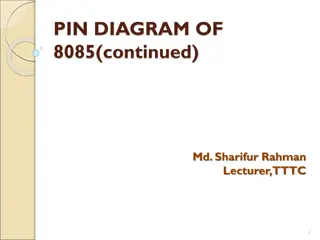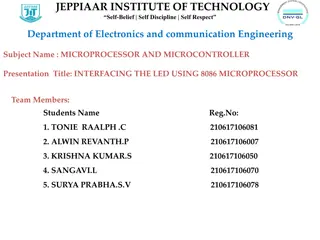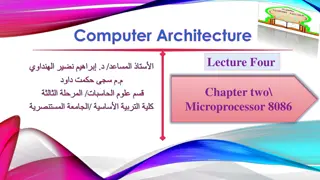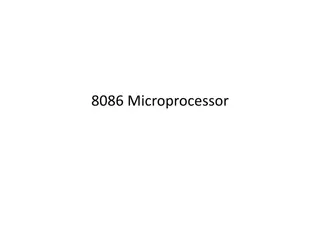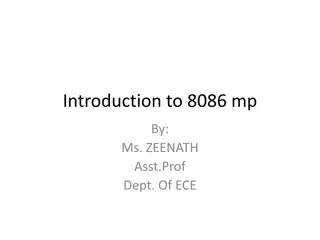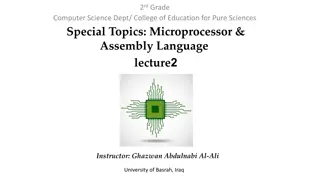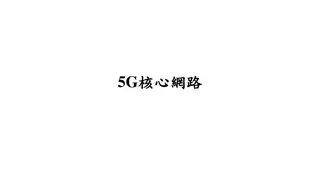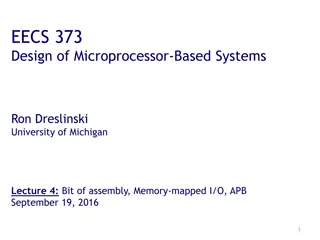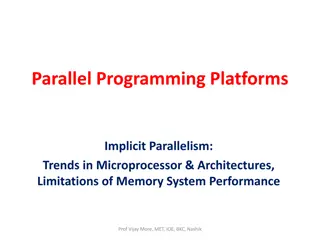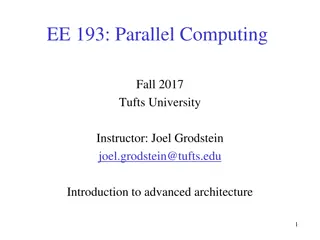Computer Components and Microprocessor: Understanding Computer Architecture
Explore the main computer components and learn about the operation of these components, including inputting, storing, processing, outputting, and controlling. Understand the role of the microprocessor in computer processing and its characteristics such as instruction set, bandwidth, and clock speed. Discover the difference between RISC and CISC architectures.
- computer components
- microprocessor
- computer architecture
- input devices
- CPU
- output devices
- primary memory
- secondary memory
Download Presentation

Please find below an Image/Link to download the presentation.
The content on the website is provided AS IS for your information and personal use only. It may not be sold, licensed, or shared on other websites without obtaining consent from the author. Download presentation by click this link. If you encounter any issues during the download, it is possible that the publisher has removed the file from their server.
E N D
Presentation Transcript
COMPUTER COMPONENTS There are 5 main computer components Input devices CPU Output devices Primary memory Secondary memory
OPERATION OF COMPUTER COMPONENTS Inputting: it is the process of entering raw data ,instruction and information into the computer with the help of input devices Storing : the computer has primary and secondary storage to store data and instruction so it store the data before sending it to CPU ,and store the processed data before display it as output. Processing: it is the process of converting the raw data into useful information. Outputting: it is the process of presenting the process data through output devices Controlling: this operation is performed by the conteol units that it is part of CPU The control unit ensures that all basic operation are executed in right manner and sequence.
A microprocessor is a component that performs the instructions and tasks involved in computer processing. In a computer system, the microprocessor is the central unit that executes and manages the logical instructions passed to it. A microprocessor may also be called a processor or central processing unit, but it is actually more advanced in terms of architectural design and is built over a silicon microchip. . . . The microprocessor contains millions of tiny components like transistors, registers, and diodes that work together.
MICROPROCESSOR It is a silicon chip that contains a CPU . In the world of personal computers ,the terms microprocessor and CPU are used interchangeably. A microprocessor is a digital electronic component with miniaturized transistors on a single semiconductor integrated circuit (IC). One or more microprocessor typically serve as a central processing unit CPU in a computer system or handheld device. Microprocessor made possible the advent of the microcomputer At the heart of all personal computers and most working station sits a Microprocessor. Microprocessor also control the logic of almost all digital devices from clock radios to fuel injection system for automobiles Three basic characteristics differentiate microprocessor Instruction set: the set of instructions that the microprocessor can execute. Bandwidth: the number of bits processed in a single instruction Clock speed: given in megahertz (MHz), the clock speed determines how many instruction per second the processor can execute. in both cases the higher the value , the more powerful the CPU
In addition to bandwidth and clock speed , microprocessors are classified as being either RISC or CISC Reduced set instruction set architecture (RISC) The main idea behind is to make hardware simpler by using an instruction set composed of a few basic steps for loading evaluating and storing operations just like an addition command will be composed of loading data , evaluating and storing Complex instruction set architecture (CISC) The main idea behind is to make hardware complex as a single instruction will do all loading , evaluating and storing operations just like a multiplication command will do stuff like loading data, evaluating and storing it
MICROPROCESSOR It is a CPU Memory , I\O ports to be connected externally MICROCONTROLLER It is a single chip Consists memory, I\O Ports
A microprocessor consists of an ALU, control unit and register array. Where ALU performs arithmetic and logical operations on the data received from an input device or memory. Control unit controls the instructions and flow of data within the computer. And, register array consists of registers identified by letters like B, C, D, E, H, L, and accumulator. What Is an ALU? An arithmetic logic unit (ALU) is a digital circuit used to perform arithmetic and logic operations. It represents the fundamental building block of the central processing unit (CPU) of a computer. Modern CPUs contain very powerful and complex ALUs. In addition to ALUs, modern CPUs contain a control unit (CU). What is Register? basically used to quickly store, accept, transfer, and operate on data based on the instructions that will be immediately used by the CPU. For CPU processing these register plays a critical role. When we give the input, these are stored and in register processes and the output is from the register only.
HOW DOES A MICROPROCESSOR WORK? The microprocessor follows a sequence: Fetch, Decode, and then Execute. Initially, the instructions are stored in the memory in a sequential order. The microprocessor fetches those instructions from the memory, then decodes it and executes those instructions till STOP instruction is reached. Later, it sends the result in binary to the output port. Between these processes, the register stores the temporarily data and ALU performs the computing functions.
WHAT IS A COMPUTER PROGRAM? A computer program is a set of instructions written in a computer programming language which direct the computer hardware to perform specific tasks A computer program can be written in any programming language depending Upon the purpose and type of the software being developed.
8085 MICROPROCESSOR 8085 is pronounced as "eighty-eighty-five" microprocessor. It is an 8-bit microprocessor designed by Intel in 1977 using NMOS technology. It has the following configuration 8-bit data bus 16-bit address bus, which can address up to 64KB Memory location through A0 to A15 The first 8 lines of address bus and 8 line of data bus are multiplexed AD0- AD 7 A 16-bit program counter A 16-bit stack pointer Six 8-bit registers arranged in pairs: BC, DE, HL Requires +5V supply to operate at 3.2 MHZ single phase clock It is used in washing machines, microwave ovens, mobile phones, et It has total 40 pins
8085 MICROPROCESSOR IT consist of three main sections , an arithmetic and logic unit (ALU), a timing and control unit and several registers ALU The arithmetic and logic unit (ALU), performs the following arithmetic and logic operations 1- addition 2- subtraction 3- logical AND 4- logical OR 5- logical EXCLUSIVE OR(XOR) 6- complement (logical NOT) 7-Incerment(add1) 8-Decerment(subtract1) 9- Left shift (add input to itself) 10-clear (result is zero)
8085 ARCHITECTURE 8085Functional units 1-Register \ memory unit 2-Arithmetic & logic unit(ALU) 3-Instruction decoder unit 4-Timing and control unit 5-Interrupts ,And , The serial communication unit
Timing and control unit The timing and control unit generates timing signals for the execution of instruction And control of peripheral devices . The organization of a microprocessor and types of registers differ from processor to processor . The timing used for the execution of instruction and control of peripherals are different for different microprocessors. The selection of a suitable microprocessor for a particular application is a tough task for an engineer The knowledge of the organization and timing and control system helps an engineer in the selection of a microprocessor The design and cost of a processor also depend on the timing structure and register organization . For the execution of an instruction a microprocessor fetches the instruction from the memory and executes it The time taken for the execution of an instruction is called instruction cycle (IC)
An instruction cycle(IC) consist of fetch cycle (FC),and execute cycle (EC) IC= FC+EC FETCH OPERATION: The fetch operation the microprocessor gets first byte of the instruction . Which is operation code (opcode). From the memory , the program counter keeps the track of address of the next instruction to be executed . In the beginning of the fetch cycle the content of the program counter is sent to the memory . This takes one clock cycle , the memory first read the opcode . This operation also takes one clock cycle, then the memory sends the opcode to the microprocessor , which takes one clock period The total time for fetch operation is the time required for fetching an opcode from the memory . This time called fetch cycle Execution operation : The opcode fetched from the memory goes to the data register DR(data\ address buffer in intel 8085), and then to instruction register IR , then it goes to the decoder circuitry is within the microprocessor. After the instruction is decoded , executed
8085 REGISTERS Registers used by the CPU to store the data, addressed and machine instruction during the program execution Special purpose are used to store a specific type of data and preformed special function General purpose Registers Are used to store the data in the temporary memory during the execution
REGISTERS:- General Register The 8085 has six general-purpose registers to store 8-bit data; these are identified as- B, C, D, E, H, and L. These can be combined as register pairs BC, DE, and HL, to perform some 16-bit operation. These registers are used to store or copy temporary data, by using instructions, during the execution of the program. 8-bit B and 8-bit C register can be used as one 16 bit BC register pair , when used as a pair the C register contains low order byte . Some instruction may use BC register as a data pointer. 8-bit D and 8-bit E register can be used as one 16- bit DE register pair , when used as a pair the E register contains low order byte. Some instruction may use DE register as a data pointer. 8-bit H and 8-bit L register can be used as one 16 bit HL register pair , when used as a pair the L register contains low order byte. Some instruction may use HL register as a data pointer used to reference memory address Stack pointer : is a16 bit register .it holds the address of the stack top , the stack is a sequence of memory location defined by the programmer . The stack is used to save the content of a register during the execution of a program . The last memory location of the occupied 4 portion of the stack is called stack top .
REGISTERS:- Accumulator or A register an 8 bit register used for arithmetic ,logic ,I\O and load \store operations Flag Register : it is 8 bit register , five bits used only as shown in fig Sign(S):set if the most significant bit of the result is set (one) Zero (Z):the zero status flag Z is set to 1 if the result of an arithmetic or logical operation is zero . For non zero result it is to 0 Auxiliary carry (AC) : set to 1 if there was a carry out from bit D3 to bit D4 of the result. Parity(P): the parity status flag is set to 1 when result of the operation contains even number of 1 s . It is set to zero when there is odd number of 1 s. Carry(CY): The carry status flag holds carry out of the most signification bit resulting from the execution of an Arithmetic operation , if there is a carry from addition or a borrow from subtraction or comparison , the carry flag CS is set to 1 , otherwise 0
Example Here two binary numbers are added. The result produced is stored in the accumulator. Now lets check what each bit means. Refer to the below explanation simultaneously to connect them with the example. Sign Flag (7th bit): It is reset(0), which means number stored in the accumulator is positive. Zero Flag (6th bit): It is reset(0), thus result of the operations performed in the ALU is non-zero. Auxiliary Carry Flag (4th bit): We can see that b3 generates a carry which is taken by b4, thus auxiliary carry flag gets set (1). Parity Flag (2nd bit): It is reset(0), it means that parity is odd. The accumulator holds odd number of 1 s. Carry Flag (0th bit): It is set(1), output results in more than 8 bit.
(c) Memory Registers There are two 16-bit registers used to hold memory addresses. The size of these registers is 16 bits because the memory addresses are 16 bits. They are :- Program Counter:This register is used to sequence the execution of the instructions. The function of the program counter is to point to the memory address from which the next byte is to be fetched. When a byte (machine code) is being fetched, the program counter is incremented by one to point to the next memory location. It is used as a memory pointer. It points to a memory location in read/write memory, called the stack. It is always incremented/decremented by 2 during push and pop operation.





